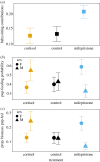The influence of stress hormones and aggression on cooperative behaviour in subordinate meerkats
- PMID: 28931736
- PMCID: PMC5627201
- DOI: 10.1098/rspb.2017.1248
The influence of stress hormones and aggression on cooperative behaviour in subordinate meerkats
Abstract
In cooperative breeders, aggression from dominant breeders directed at subordinates may raise subordinate stress hormone (glucocorticoid) concentrations. This may benefit dominants by suppressing subordinate reproduction but it is uncertain whether aggression from dominants can elevate subordinate cooperative behaviour, or how resulting changes in subordinate glucocorticoid concentrations affect their cooperative behaviour. We show here that the effects of manipulating glucocorticoid concentrations in wild meerkats (Suricata suricatta) on cooperative behaviour varied between cooperative activities as well as between the sexes. Subordinates of both sexes treated with a glucocorticoid receptor antagonist (mifepristone) exhibited significantly more pup protection behaviour (babysitting) compared to those treated with glucocorticoids (cortisol) or controls. Females treated with mifepristone had a higher probability of exhibiting pup food provisioning (pup-feeding) compared to those treated with cortisol. In males, there were no treatment effects on the probability of pup-feeding, but those treated with cortisol gave a higher proportion of the food they found to pups than those treated with mifepristone. Using 19 years of behavioural data, we also show that dominant females did not increase the frequency with which they directed aggression at subordinates at times when the need for assistance was highest. Our results suggest that it is unlikely that dominant females manipulate the cooperative behaviour of subordinates through the effects of aggression on their glucocorticoid levels and that the function of aggression directed at subordinates is probably to reduce the probability they will breed.
Keywords: aggression; behavioural plasticity; cooperation; glucocorticoids; sociality; stress.
© 2017 The Author(s).
Conflict of interest statement
We have no competing interests.
Figures


Similar articles
-
Suppressing subordinate reproduction provides benefits to dominants in cooperative societies of meerkats.Nat Commun. 2014 Jul 22;5:4499. doi: 10.1038/ncomms5499. Nat Commun. 2014. PMID: 25047446 Free PMC article.
-
Adaptive suppression of subordinate reproduction in cooperative mammals.Am Nat. 2010 Nov;176(5):664-73. doi: 10.1086/656492. Am Nat. 2010. PMID: 20846043
-
Pregnancy reduces concurrent pup care behaviour in meerkats, generating differences between dominant and subordinate females.J Anim Ecol. 2023 Jul;92(7):1431-1441. doi: 10.1111/1365-2656.13963. Epub 2023 Jun 5. J Anim Ecol. 2023. PMID: 37277989
-
Meerkat manners: Endocrine mediation of female dominance and reproductive control in a cooperative breeder.Horm Behav. 2022 Sep;145:105245. doi: 10.1016/j.yhbeh.2022.105245. Epub 2022 Aug 18. Horm Behav. 2022. PMID: 35988450 Review.
-
A tale of two hierarchies: Hormonal and behavioral factors underlying sex differences in social dominance in cooperative breeding callitrichids.Horm Behav. 2023 Jan;147:105293. doi: 10.1016/j.yhbeh.2022.105293. Epub 2022 Dec 1. Horm Behav. 2023. PMID: 36463691 Review.
Cited by
-
Cooperation with closely bonded individuals reduces cortisol levels in long-tailed macaques.R Soc Open Sci. 2020 May 13;7(5):191056. doi: 10.1098/rsos.191056. eCollection 2020 May. R Soc Open Sci. 2020. PMID: 32537186 Free PMC article.
-
The call of the wild: using non-model systems to investigate microbiome-behaviour relationships.J Exp Biol. 2021 May 15;224(10):jeb224485. doi: 10.1242/jeb.224485. Epub 2021 May 14. J Exp Biol. 2021. PMID: 33988717 Free PMC article. Review.
-
Cooperation and Cheating through a Secreted Aminopeptidase in the Pseudomonas aeruginosa RpoS Response.mBio. 2020 Mar 17;11(2):e03090-19. doi: 10.1128/mBio.03090-19. mBio. 2020. PMID: 32184248 Free PMC article.
-
The development of individual differences in cooperative behaviour: maternal glucocorticoid hormones alter helping behaviour of offspring in wild meerkats.Philos Trans R Soc Lond B Biol Sci. 2019 Apr 15;374(1770):20180117. doi: 10.1098/rstb.2018.0117. Philos Trans R Soc Lond B Biol Sci. 2019. PMID: 30966876 Free PMC article.
-
Responses to pup vocalizations in subordinate naked mole-rats are induced by estradiol ingested through coprophagy of queen's feces.Proc Natl Acad Sci U S A. 2018 Sep 11;115(37):9264-9269. doi: 10.1073/pnas.1720530115. Epub 2018 Aug 27. Proc Natl Acad Sci U S A. 2018. PMID: 30150390 Free PMC article.
References
-
- Creel S. 2001. Social dominance and stress hormones. Trends Ecol. Evol. 16, 491–497. (10.1016/S0169-5347(01)02227-3) - DOI
-
- Creel S, Dantzer B, Goymann W, Rubenstein DR. 2013. The ecology of stress: effects of the social environment. Funct. Ecol. 27, 66–80. (10.1111/j.1365-2435.2012.02029.x) - DOI
-
- Goymann W, Wingfield JC. 2004. Allostatic load, social status and stress hormones: the costs of social status matter. Anim. Behav. 67, 591–602. (10.1016/j.anbehav.2003.08.007) - DOI
-
- Hackländer K, Möstl E, Arnold W. 2003. Reproductive suppression in female alpine marmots, Marmota marmot. Anim. Behav. 65, 1133–1140. (10.1006/anbe.2003.2159) - DOI
MeSH terms
Substances
Grants and funding
LinkOut - more resources
Full Text Sources
Other Literature Sources
Medical

